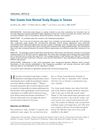TLDR The boy's hair loss was likely caused by a fungal infection.
A 5-year-old boy experienced a solitary patch of hair loss on the left frontal area of his scalp, which persisted despite initial treatment with oral antibiotics. The affected area was a 3×3-cm erythematous, crusted, scaling patch with broken hairs, but without purulent drainage or follicular pustules. The boy lived with 2 healthy cats and 1 dog, but Wood light fluorescence was absent, and initial potassium hydroxide preparation was nondiagnostic. However, a fungal culture of the broken hairs and scale showed some growth after 5 days, indicating a possible fungal infection as the cause of the alopecia.
 1 citations
,
August 2022 in “JAAD case reports”
1 citations
,
August 2022 in “JAAD case reports” Tofacitinib and oral minoxidil may help treat Sisaipho alopecia areata.
 6 citations
,
December 2014 in “Clinical and Experimental Dermatology”
6 citations
,
December 2014 in “Clinical and Experimental Dermatology” Hair density and thickness decrease in all scalp areas for East Asians with AGA.
 58 citations
,
September 2012 in “Dermatologic Clinics”
58 citations
,
September 2012 in “Dermatologic Clinics” Male pattern hair loss caused by follicular miniaturization; early diagnosis and treatment can reduce psychological burden.
 24 citations
,
September 2012 in “Dermatologic Surgery”
24 citations
,
September 2012 in “Dermatologic Surgery” The conclusion is that normal scalp hair counts for Taiwanese people were established, showing age-related differences but not sex or scalp location differences.
 76 citations
,
December 2006 in “Journal of Dermatological Science”
76 citations
,
December 2006 in “Journal of Dermatological Science” Japanese women typically start experiencing hair loss after 40, with reduced hair density and thickness being the main factors.
 6 citations
,
August 2006 in “Journal of Cutaneous Pathology”
6 citations
,
August 2006 in “Journal of Cutaneous Pathology” Two teenage brothers had a rare, treatment-resistant form of female-pattern hair loss with unusual scalp changes.
January 2001 in “대한피부과학회지” Horizontal sectioning helps diagnose hair loss, but Korean follicle differences matter.






